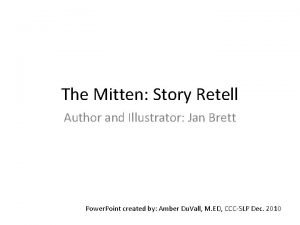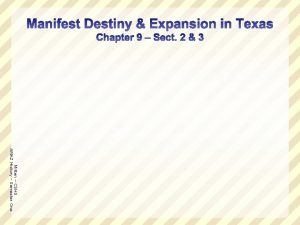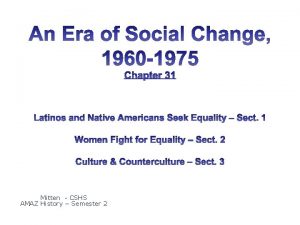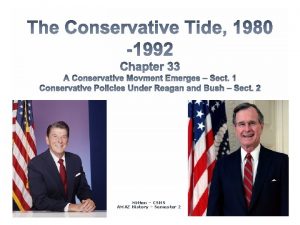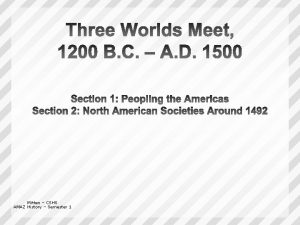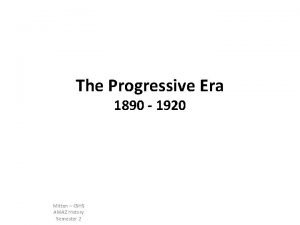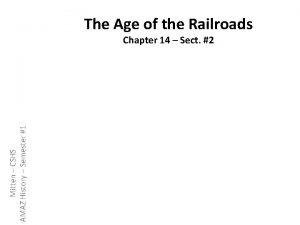Mitten CSHS AMAZ History Semester 1 20092010 Another










- Slides: 10

Mitten – CSHS AMAZ History – Semester 1 2009/2010

Another Revolution Affects America Changes in Manufacturing By 1801, inventor Eli Whitney pioneers use of interchangeable parts Interchangeable parts are identical pieces used to assemble products Factory system: power-driven machinery, workers with different tasks Mass production is production of goods in large quantities Industrial Revolution – social, economic reorganization: machines replace hand tools large-scale factory production develops result of manufacturing changes

Another Revolution Great Britain Starts a Revolution In 18 th century, British first generate power from steam , coal Develop power-driven machines for mass production, build factories The Industrial Revolution in the United States After independence, U. S. income primarily from international trade Embargo Act of 1807, War of 1812 blockade shut down trade, shipping Americans begin to invest in domestic industries

Another Revolution New England Industrializes Samuel Slater builds first thread factory in Pawtucket, RI (1793) Lowell, Appleton, Jackson mechanize all stages cloth making (1813) Build weaving factories in Waltham, Massachusetts and Lowell, Massachusetts By late 1820’s, Lowell becomes booming manufacturing center Thousands – mostly young women – leave family farms to work in Lowell

Two Economic Systems Develop Agriculture in the North Cash crops do not grow well in Northern soil and climate Farms in North smaller than South In Old Northwest, farmers raise 1 or 2 types of crops, livestock sell farm products in city; buy other items Grains do not need much labor or yield great profit: need no slaves Northern slavery dying out by late 1700’s most Northern states abolish slavery by 1804

Two Economic Systems Cotton Is King in the South Eli Whitney’s cotton gin allows farmers to grow cotton for profit Great demand for cotton in Britain, growing demand in North Poor non-slaveholding farmers go west to cultivate corn Plantation system established in Louisiana, Mississippi, Alabama Slavery Becomes Entrenched Cotton hugely profitable; by 1820’s demand for slaves increases Increase in cotton production parallels increase in slave population

The American System Uniting the Nation’s Economic Interests Madison’s plan to unite country’s regions, create strong economy: develop transportation systems; make internal improvements establish protective tariff revive national bank House Speaker Henry Clay promotes plan as the American System: North produces manufactured goods South and West produce food, cotton national currency, transportation facilitate trade all regions sustain the others making U. S. economically independent

The American System Erie Canal and Other Internal Improvements Railroads not yet in common use; first steam engine built 1825 Many state build turnpikes, toll roads pay for themselves Federal government funds highways to connect different regions 1838, National Road extends from Cumberland, Maryland to Vandalia, Illinois Erie Canal links Hudson River to Lake Erie: Atlantic to Great Lakes Other states build over 3000 miles of canals by 1837

The American System Tariffs and the National Madison proposes Tariff of Bank 1816 – tariff on imports increases cost of foreign goods people more likely to buy American goods helps pay for improvements Northeast welcomes tariff; South, West resent higher prices Clay, Calhoun sway congressmen from South, West to approve Most leaders agree national bank, national currency benefit all Tariffs and the National Bank In 1816, Second National Bank of the United States chartered for 20 years James Monroe elected president (1816), begins “Era of good feelings”

Credit http: //cache. eb. com/eb/image? id=92852&rend. Type. Id=4 http: //bikyamasr. files. wordpress. com/2009/09/andrew-jackson. jpg Notes: http: //www. digitalhistory. uh. edu/database










